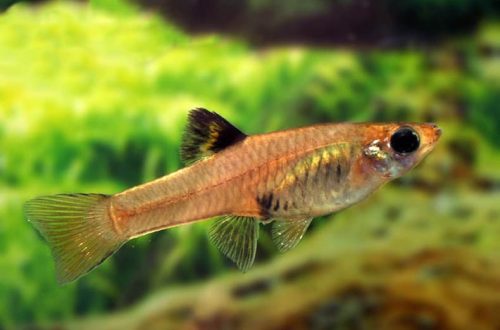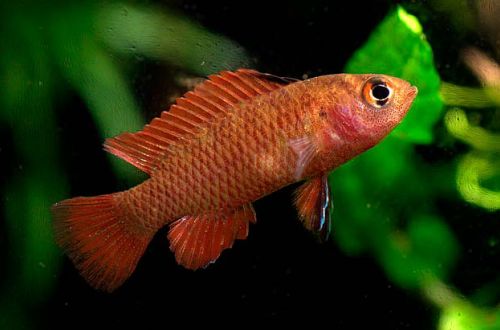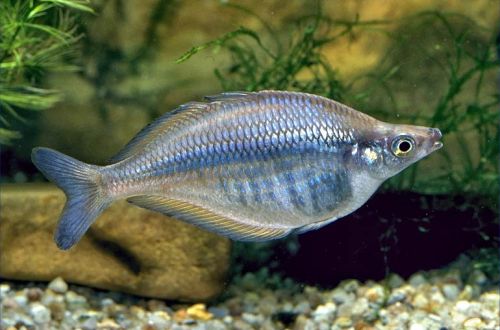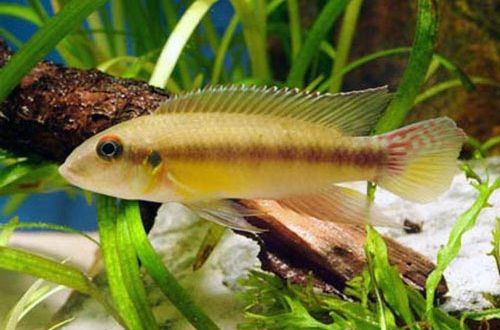
Yellow Kribensis
The yellow-bellied parrot cichlid, Yellow-bellied Cribensis or Yellow Cribensis, scientific name Pelvicachromis humilis, belongs to the Cichlidae family. Beautiful bright, but wayward fish. It calmly treats other species, but it is not so easy to find suitable neighbors among relatives. As for the conditions of detention, they will not cause problems even for a novice aquarist.

Contents
Habitat
Occurs from the Western tip of Africa from the territory of modern Sierra Leone, Liberia, Guinea. It lives in small rivers and their tributaries. The landscape in this region is hilly, so the rivers have many rapids, but the current is calm, and the water is rich in dissolved oxygen.
Brief information:
- The volume of the aquarium – from 110 liters.
- Temperature – 24-27°C
- Value pH — 5.5–8.0
- Water hardness – soft to medium hard (5-12 dGH)
- Substrate type – sandy or fine gravel
- Lighting – subdued
- Brackish water – no
- Water movement is weak
- The size of the fish is about 13 cm.
- Meals – any
- Temperament – conditionally peaceful, with the exception of spawning periods
- Keeping singly in a formed male/female pair
Description
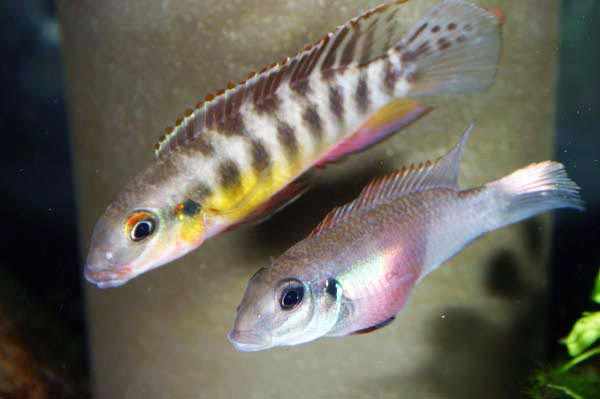
Adult individuals reach a length of 12–13 cm. They have an elongated, swift body. The color of the upper part is dark olive green, smoothly turning into a light belly. Males, unlike females, have more elongated and pointed dorsal and anal fins, dark vertical stripes are present in the body pattern, and the abdomen has a yellowish tint. Females are noticeably smaller and simpler in color, the only distinguishing feature is the pink abdomen.
Food
They accept all types of dry food. It is necessary to provide that proteins and vegetable components are necessarily present in the composition. You can diversify the diet with live and frozen food, slices of peeled spinach, peas, etc.
Maintenance and care, arrangement of the aquarium
The recommended size of the aquarium for one pair of fish starts from 110 liters. The design uses a sandy or finely gravel substrate, a lot of shelters – these can be snags, decorative objects imitating grottoes, crevices, caves, as well as ordinary ceramic pots turned over on their side. Plants are not required. The lighting level is subdued.
The operation of the equipment, in particular the filtration system, should not create excessive internal current, since Yellow Cribensis does not perceive fast current well. It is also sensitive to dissolved oxygen content, so additional aeration is welcome.
Behavior and Compatibility
Calmly refers to representatives of other species. It goes well with many fish that can live in similar conditions. Due to its small size, it is worth avoiding sharing with large and aggressive fish.
Relationships within the species are much more complicated; yellow-bellied Cribensis form a pair from a young age, which persists for a long time. In a small aquarium (in this case it is 110 liters), the male and female will be extremely belligerent towards their relatives, considering them competitors on their territory. In addition, if a male or female was originally kept alone, that is, they never formed a pair, then the addition of another Kribensis is excluded, since a weaker individual will probably be killed.
Breeding / breeding
In general, the breeding process is quite simple, the main problem is to find a suitable pair. There are only two options here. The first is to acquire a dozen young fish, among which, as they grow older, at least one pair will almost certainly appear, but the rest will have to be resettled. The second is to buy an already formed pair.
The stimulus for the beginning of the mating season is the establishment of water conditions at the following values: pH 5.5–6.5, dGH 5–10, temperature 23–26°C. After a short courtship, the couple chooses a spawning site – a cave or any other suitable shelter. The female retires in it for several days, where she lays eggs and guards the clutch until the fry appear. The male at this time remains outside for their protection. The female leaves the shelter already together with the offspring, which stays with their parents for a few more weeks, during which adult fish continue to protect them. In case of danger, the fry can take refuge in the mouth of one of the parents, and the other will repulse the potential “intruder”.
Fish diseases
The main cause of most diseases is unsuitable living conditions and poor-quality food. If the first symptoms are detected, you should check the water parameters and the presence of high concentrations of hazardous substances (ammonia, nitrites, nitrates, etc.), if necessary, bring the indicators back to normal and only then proceed with treatment. Read more about symptoms and treatments in the Aquarium Fish Diseases section.



